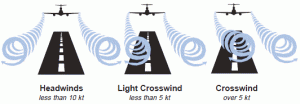Safety Promotion & Education
Aeroplanes and helicopters trail violent spirals of air from their wingtip or rotor
The Vortex
As a wing or rotor generates more lift, pressure differences above and below increase, putting more energy into the vortices. So…for each aircraft, increased weight means stronger vortices.
As an aircraft slows, the pressure difference above and below increases. So…as an aircraft slows, total vortex energy increases.
The position of flaps and landing gear as well as the location of engines and tail configuration all have their influence, as does twin rotor versus tail rotor helicopter configuration. So…aircraft configuration modifies the vortex pattern and persistence. And persistence is a major problem.
Since cold air is more dense than warm air, it has more "punch". So…air density influences vortex strength.
A vortex will decay with time as the swirl increases in diameter and mixes with the surrounding air. So…until the vortex collapses, it remains potentially dangerous.
As the wing or rotor moves through the air, the trailing air is thrust downwards. So… vortices descend below the flight path.
Vortex movement depends on altitude.
At higher altitudes, where aircraft fly very fast, a vortex, which persists for the typical two minutes, is active as far as 16 NM behind and 1000 ft below the aircraft.
At lower altitudes, more common to the VFR pilot, the two minutes persistence time translates into shorter distances because of the slower speeds at these altitudes.
At very low altitudes, such as during takeoff, landing, or an overshoot, vortices behave in a substantially different manner.
So, you see, the area of hazard is not necessarily aligned with the flight path of the aircraft ahead.
Safe Separation
The tower controller will provide separation for departure, depending on the weight category of your aircraft and the one ahead: ultralight, light, medium, heavy. Under some conditions, you may waive that separation. However, at uncontrolled airports and at times other than takeoff, you will have to provide your own safe spacing.
Takeoff
Plan to rotate prior to the previous aircraft's rotation point. Keep your flight path above theirs or conduct an off-centreline climb on the upwind side. After another aircraft has landed, do not lift off until beyond the touchdown point.
Approach and Landing
Stay above the preceding aircraft's flight path, and plan your touchdown point past theirs. That means avoiding a long low final.
Around Airports
Keep a sharp lookout at all times, and listen to the radio as a guide for traffic movement. Helicopters are hard to spot but they operate almost anywhere, and they generate vortices more violent than those of a fixed-wing aircraft of comparable weight.
Wake turbulence is invisible only to those who cannot see it in the mind's eye. Be alert to the hazard and take the appropriate avoidance action.
This Take-5 supersedes the original brochure TP 2233E—Living With Vortices, and is available on our Web site. —Ed.
Living with Vortices - TP 2228-24
(PDF, 83 KB)

